Your visitors already tell you what they want—right inside your site’s search box. Treat that stream of queries as a living focus group and you’ll uncover content gaps, product demand, and conversion friction you can actually act on. If someone asks, what is internal search in marketing? It’s the demand signal generated by your own audience as they try to find value on your property—prime fuel for content strategy, UX decisions, and revenue growth.
Why internal search is a goldmine
People who use your website internal search engine are high-intent. They’re not browsing; they’re hunting. That means two things:
- Their queries reveal what matters this week, not last year.
- Their success or failure moves business metrics quickly—bounce, conversion, support load, even AOV.
Across e-commerce, SaaS, media, and marketplaces, teams that consistently read this signal find low-lift wins (rename a product, surface a page, add synonyms) and roadmap-level insights (new categories, missing docs, weak navigation).
The metrics that matter
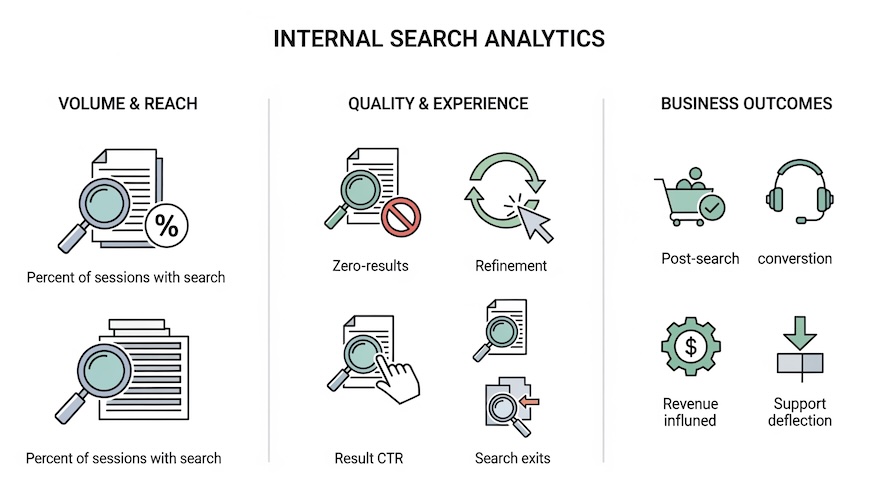
Think of internal search analytics as three layers: volume, quality, and outcomes. Use them together—not in isolation.
Volume & reach
- % of sessions with search: If it’s too low, search may be invisible or users rely on menus. If it’s too high, navigation might be failing. Both extremes signal friction.
- Query volume & growth: Spot rising topics early (seasonality, campaigns, new competitor names).
Quality & experience
- Zero-results rate: Classic “internal site search no results” problem. Every zero is a content or synonym opportunity. Prioritize high-intent queries (e.g., “pricing”, SKU names).
- Refinement rate & time to first click: Users retype, add words, or pogo-stick when results don’t match mental models.
- Result click-through rate: Low CTR on top results suggests ranking or labeling issues, not just content gaps.
- Search exits: Searches that end the session signal disappointment—or, occasionally, instant answers.
Business outcomes
- Conversion after search vs. no search: If post-search conversion is higher, double down on making search easier to find and faster to use. If it’s lower, quality is the culprit.
- Revenue influenced by search: Attribute orders or leads touched by search to quantify impact.
- Support deflection: For docs hubs, watch ticket rate after a help-center search.
Pro tip: Frame these as internal search metrics for opportunity—“What moves the needle if we fix it?”—rather than as vanity numbers.
What patterns to mine—and how to interpret them
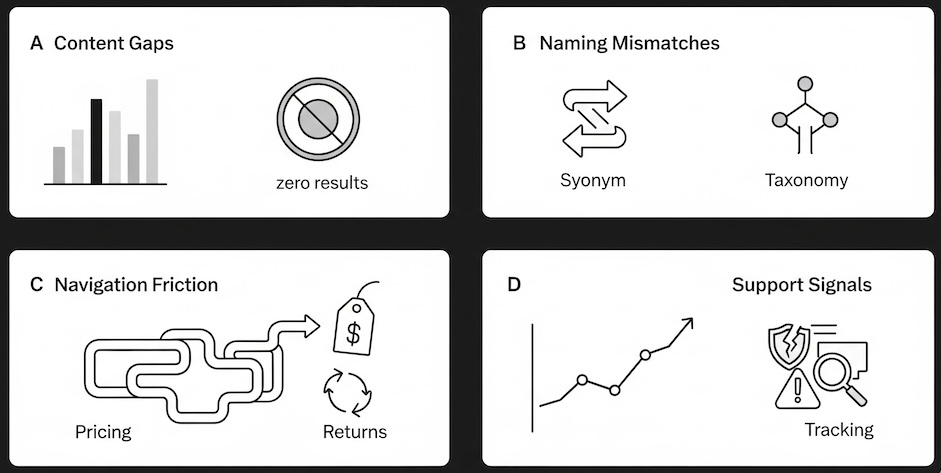
- Content gaps
Queries with high volume and high zero-results rate are your next articles, category pages, or FAQs. Example: frequent searches for “SOC 2 report” on a SaaS site means your trust center content is buried or missing. - Product gaps & naming mismatches
If users search “winter boots waterproof” but product names emphasize “snow hikers,” add synonyms, update filters, and consider renaming. That’s internal site search optimization, not just content creation. - Language and intent mismatches
People search how they talk. If results tank for “cancel account” but soar for “delete subscription,” you’ve learned the vocabulary your UI and docs should adopt. - Navigation friction
Spikes for “pricing,” “returns,” or “opening hours” indicate buried essentials—especially on mobile. Move them up in the IA and reduce dependency on search. - Support signals
Rising searches for error codes, outages, or “tracking order” predict support volume. Redirect to status pages or self-serve flows before tickets surge.
Segments that sharpen insight
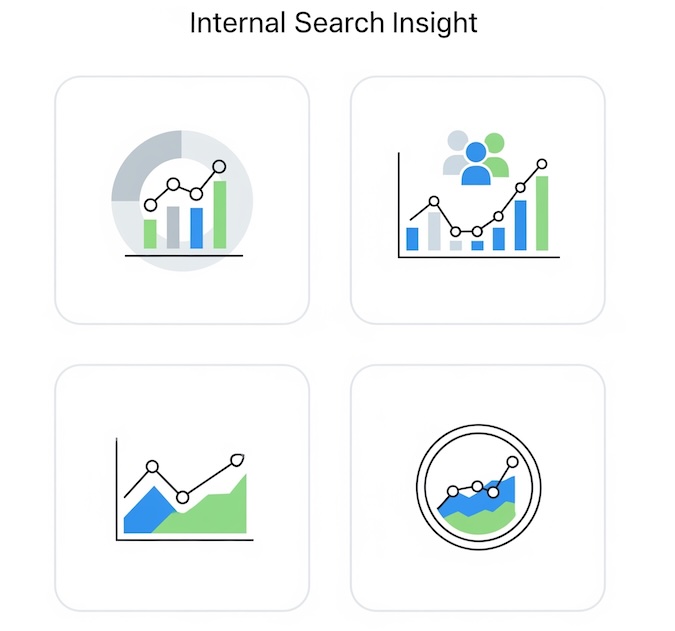
- Device & speed: Mobile searchers may use shorter, fuzzier terms; tie this to performance (slow pages trigger more searches).
- Traffic source: Paid social visitors often search for the promise from the ad; organic visitors may seek category breadth.
- Lifecycle: New users look for fundamentals (“pricing”, “how it works”); customers search specifics (SKUs, docs, integrations).
- Geography & locale: Regional terms surface (“trainers” vs. “sneakers”), informing translation and merchandising.
E-commerce vs. SaaS vs. Media: what “good” looks like
- E-commerce: Post-search conversion should beat sitewide; zero-results on SKU and attribute terms deserves same-week fixes.
- SaaS/B2B: Success equals fewer bounces to Contact Us and more engagement with pricing, integrations, and case studies.
- Media/Publishing: Search should deepen session depth—more article views per visit and better topic personalization.
Turning insights into decisions
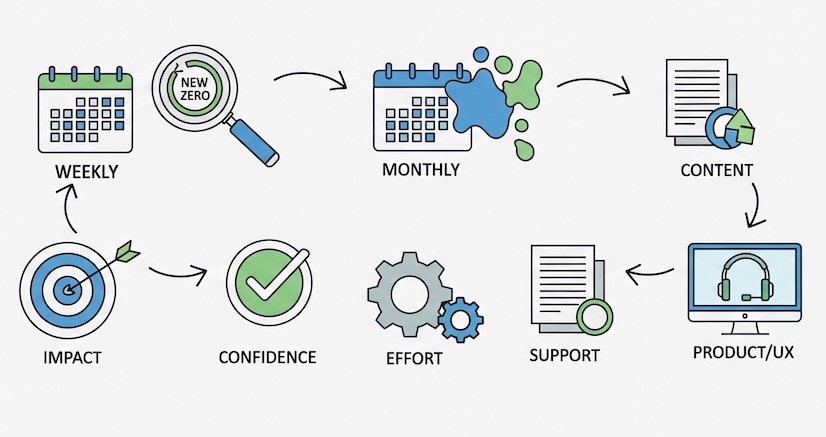
Create a lightweight, repeatable process—no code talk required:
1) Weekly signal, monthly themes
- Weekly: Top new queries, top zero-results, fastest risers, and searches with high exits.
- Monthly: Theme clusters (e.g., “returns”, “compatibility”, “pricing”), with recommended content or IA updates.
2) Opportunity sizing
Score each idea with ICE (Impact, Confidence, Effort). A synonym change with 10k affected searches and high confidence outranks a new, complex page.
3) Cross-functional loop
- Content/SEO: Build pages that match on-site demand, not just external keywords.
- Product/UX: Rename confusing features, expose popular filters, reorder top results.
- Support/Success: Convert frequent “how do I…” queries into self-serve guides.
This is where internal site search optimization becomes a program, not a one-off cleanup.
Common pitfalls to avoid
- Chasing head terms only: Long-tail queries (“reset 2FA authenticator”) often have higher intent and clearer fixes.
- Ignoring seasonality: Back-to-school or holiday spikes will skew “top searches.” Compare YoY, not just WoW.
- Confusing lab with field: Stakeholder demos aren’t user reality. Rely on actual query behavior and post-search outcomes.
- Treating synonyms as an afterthought: Language drifts. Your synonym list should too—especially across locales.
- Overreacting to tiny volumes: Set a sensible floor (e.g., 50 queries/month) before acting, unless a query is mission-critical (like “refund”).
Scorecard to align stakeholders
A concise, executive-friendly set of KPIs keeps momentum:
- % sessions using search (target: healthy middle aligned to IA quality)
- Zero-results rate (target: continuously declining)
- Post-search conversion uplift vs. no-search sessions (target: positive and growing)
- Top 10 query coverage (target: clear destination page and satisfying result for each)
- Time to remediate high-impact zero-result queries (target: days, not months)
Present these with one or two real-query stories per month to make the data visceral.
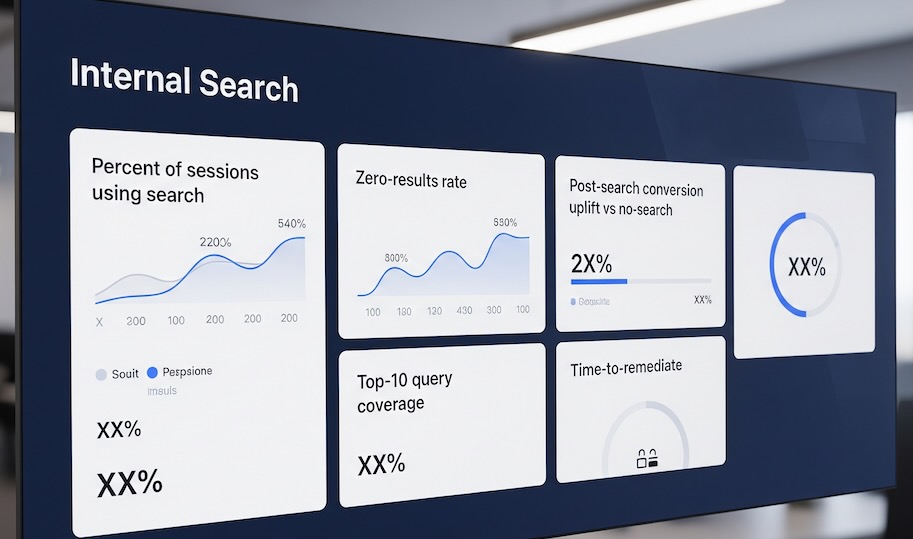
FAQ for stakeholders
- Isn’t this just another dashboard? No—internal search reflects what users actually ask you, not what we think they want.
- Will this cannibalize SEO plans? It complements them. On-site demand often mirrors external demand; internal trends validate where to invest.
- How quickly can we see impact? Fixes to language, synonyms, or navigation labels often move metrics within a sprint.
One-sentence definitions to keep everyone aligned
- Internal search analytics: The practice of analyzing on-site queries and outcomes to improve content, UX, and revenue.
- Internal site search optimization: A continuous program to reduce zero-results, improve result relevance, and connect users to value faster.
- What is internal search in marketing? A first-party intent signal that reveals unmet demand and guides messaging, content, and product decisions.
Use these insights to build a roadmap your audience already asked for—because they literally typed it into your search box.




